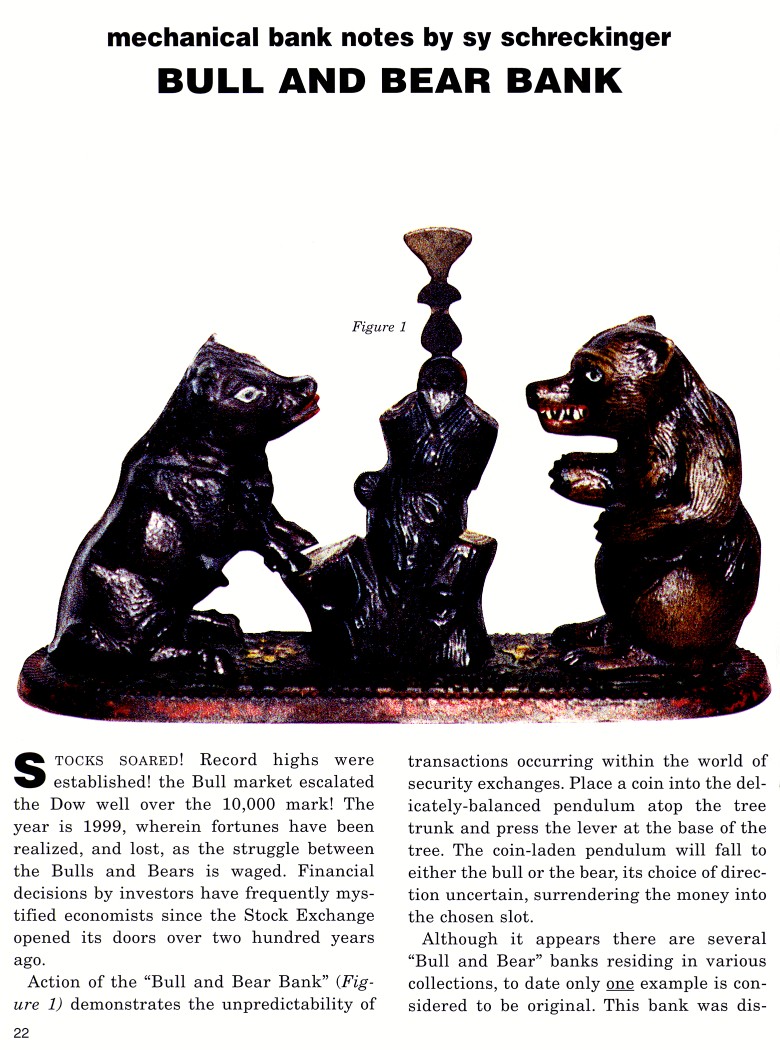|
Bull and Bear Bank
by Sy Schreckinger – ANTIQUE TOY WORLD Magazine – October, 1999
Stocks soared! Record highs were
established! the Bull market escalated the Dow well over the 10,000 mark!
The year is 1999, wherein fortunes have been realized, and lost, as the
struggle between the Bulls and Bears is waged. Financial decisions by
investors have frequently mystified economists since the Stock Exchange
opened its doors over two hundred years ago.
Action of the "Bull and Bear Bank" (Figure 1) demonstrates the
unpredictability of transactions occurring within the world of security
exchanges. Place a coin into the delicately-balanced pendulum atop the
tree trunk and press the lever at the base of the tree. The coin-laden
pendulum will fall to either the bull or the bear, its choice of direction
uncertain, surrendering the money into the chosen slot.
Although it appears there are several "Bull and Bear" banks residing
in various collections, to date only one example is considered to be
original. This bank was discovered sometime in the 1930s by mechanical
bank dealer, Mr. Norman E. Sherwood. He found it in the workroom of master
bank designer, Charles A. Bailey, at the dismantled J. and E. Stevens
Foundry in Cromwell, Connecticut. Mr. Sherwood subsequently placed the
bank into the pioneer collection of Walter P. Chrysler. It was later
purchased by David Hollander who, several years afterward, sold it to Leon
Perelman, curator of the Perelman Toy Museum in Philadelphia,
Pennsylvania. Mr. Steve Steckbeck, its present owner, acquired the bank in
1988 when Mr. Perelman disbanded his prestigious facility, and sold his
entire toy collection.
When Mr. Sherwood located the "Bull and Bear Bank" it was fully
operational but lacked the figure of the bear. However, he utilized a cast
iron still bank (i.e. "Begging Bear"; Refer to Moore book, #715) to
replace the absent original. When Mr. Steckbeck obtained the bank, he
replaced the cast iron "Begging Bear" still bank with a skillfully-crafted lead alloy bear created in a style commensurate to Charles A.
Bailey's original lead alloy bull figure.
Interestingly, although the base, tree trunk, and pendulum are
fashioned of cast iron, the figure of the bull and the bear are composed
of a lead alloy. This marriage of metals occurred in two other mechanical
banks designed by Mr. Bailey and manufactured by J. and E. Stevens, namely
"Bismark Bank" (refer to Antique Toy World,
March, 1995) and "Germania
Exchange Bank".
To caution readers, approximately sixty years ago several
unauthorized copies of the "Bull and Bear Bank" were produced. Whether
these examples were created to intentionally deceive collectors or merely
to satisfy the desires of individuals who wished to obtain
reasonably-priced facsimiles of a great rarity, has never been
ascertained. Nevertheless, since their creation many of these spurious
mechanicals have been misrepresented, and may now be in the collections of
unsuspecting individuals. The detail, quality, and craftsmanship reflected
in banks created by Charles Bailey and produced by J. and E. Stevens
Company are sadly lacking in these reproductions. However, although there
is no comparison between these and the original example seen in Figure 1,
the most effective method of detection is the underside of the bank's
base. The authentic "Bull and Bear Bank" is not only finely cast, but
utilizes a spoke-type, "open" design underneath each of the animals. The
bogus examples exhibit heavy, crudely cast, solid undersides.
In an attempt to determine why only one authentic "Bull and Bear
Bank" has surfaced, it is the contention of several bank historians and
collectors that it may have been a specialty item designed for a specific
event, ergo severely limiting production. Another interesting hypothesis
is that it might have been an early Bailey creation, put aside to await an
opportune time for future production. Perhaps the Stock Market crash of
1929 was responsible for cessation of the project by the J. and E. Stevens
Company, based upon the assumption that it would have proven to be an
unpopular reminder of the traumatic event.
I am including a base diagram (Figure 2) of the original "Bull and
Bear Bank" (Figure 1). Be suspicious of the originality of any example
that does not adhere precisely to the appearance of the bank shown in
Figure 1, and/or the dimensions specified in Figure 2.
|


